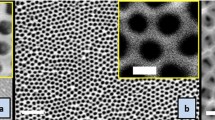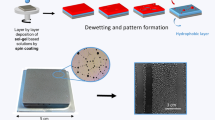Abstract
The superhydrophobicity of plant leaves is a benefit of the hierarchical structures of their surfaces. These structures have been imitated in the creation of synthetic surfaces. In this paper, a novel process for fabrication of biomimetic hierarchical structures by electrochemical deposition of a metal on porous alumina is described. An aluminum specimen was anodically oxidized to obtain a porous alumina template, which was used as an electrode to fabricate a surface with micro structures through electrochemical deposition of a metal such as nickel and copper after the enlargement of pores. Astonishingly, a hierarchical structure with nanometer pillars and micrometer clusters was synthesized in the pores of the template. The nanometer pillars were determined by the nanometer pores. The formation of micrometer clusters was related to the thin walls of the pores and the crystallization of the metal on a flat surface. From the as-prepared biomimetic surfaces, lotus-leaf-like superhydrophobic surfaces with nickel and copper deposition were achieved.
Similar content being viewed by others
References
Blossey R. Self-cleaning surfaces-virtual realities. Nature Materials, 2003, 2, 301–306.
Neinhuis C, Barthlott W. Characterization and distribution of water-repellent, self-cleaning plant surfaces. Annals of Botany, 1997, 79, 667–677.
Zhou Y, Li M, Su B, Lu Q. Superhydrophobic surface created by the silver mirror reaction and its drag-reduction effect on water. Journal of Materials Chemistry, 2009, 19, 3301–3306.
Cottin-Bizonne C, Barrat J L, Bocquet L, Charlaix E. Low-friction flows of liquid at nanopatterned interfaces. Nature Materials, 2003, 2, 237–240.
Cao L, Jones A K, Sikka V K, Wu J, Gao D. Anti-icing superhydrophobic coatings. Langmuir, 2009, 25, 12444–12448.
Barthlott W, Neinhuis C. Purity of the sacred lotus or escape from contamination in biological surfaces. Planta, 1997, 202, 1–8.
Koch K, Dommisse A, Barthlott W. Chemistry and crystal growth of plant wax tubules of lotus (Nelumbo nucifera) and nasturtium (Tropaeolum majus) leaves on technical substrates. Crystal Growth & Design, 2006, 6, 2571–2578.
Cassie A B D, Baxter S. Wettability of porous surfaces. Transactions of the Faraday Society, 1944, 40, 546–551.
Xi J, Feng L, Jiang L. A general approach for fabrication of superhydrophobic and superamphiphobic surfaces. Applied Physics Letters, 2008, 92, 053102-1–3.
Shirtcliffe N J, McHale G, Newton M I, Chabrol G, Perry C C. Dual-scale roughness produces unusually water-repellent surfaces. Advanced Materials, 2004, 16, 1929–1932.
Ren H X, Huang X J, Yarimaga O, Choi Y K, Gu N. A cauliflower-like gold structure for superhydrophobicity. Journal of Colloid and Interface Science, 2009, 334, 103–107.
Wang L, Guo S, Hu X, Dong S. Facile electrochemical approach to fabricate hierarchical flowerlike gold microstructures: Electrodeposited superhydrophobic surface. Electrochemistry Communications, 2008, 10, 95–99.
Wang L, Guo S, Dong S. Facile electrochemical route to directly fabricate hierarchical spherical cupreous microstructures: Toward superhydrophobic surface. Electrochemistry Communications, 2008, 10, 655–658.
Bhushan B, Koch K, Jung Y C. Biomimetic hierarchical structure for self-cleaning. Applied Physics Letters, 2008, 93, 093101-1–3.
Yuan Z, Chen H, Zhang J. Facile method to prepare lotus-leaf-like super-hydrophobic poly (vinyl chloride) film. Applied Surface Science, 2008, 254, 1593–1598.
Bok H M, Shin T Y, Park S. Designer binary nanostructures toward water slipping superhydrophobic surfaces. Chemistry of Materials, 2008, 20, 2247–2251.
Zhang L, Zhou Z, Cheng B, DeSimone J M, Samulski E T. Superhydrophobic behavior of a perfluoropolyether lotus-leaf-like topography. Langmuir, 2006, 22, 8576–8580.
Ding B, Ogawa T, Kim J, Fujimoto K, Shiratori S. Fabrication of a super-hydrophobic nanofibrous zinc oxide film surface by electrospinning. Thin Solid Films, 2008, 516, 2495–2501.
Crick C R, Parkin I P. A single step route to superhydrophobic surfaces through aerosol assisted deposition of rough polymer surfaces: Duplicating the lotus effect. Journal of Materials Chemistry, 2009, 19, 1074–1076.
Bayer I S, Steele A, Martorana P J, Loth E, Miller L. Superhydrophobic cellulose-based bionanocomposite films from Pickering emulsions. Applied Physics Letters, 2009, 94, 163902-1–3.
Wang H, Wang H W. Analysis on porous aluminum anodic oxide film formed in Re-OA-H3PO4 solution. Materials Chemistry and Physics, 2006, 97, 213–218.
Martin C R. Nanomaterials-a membrane-based synthetic approach. Science, 1994, 266, 1961–1966.
Park S, Song Y J, Boo H, Han J, Chung T D, Arrayed hybrid nanoporous Pt pillars. Electrochemistry Communications, 2009, 11, 2225–2228.
Sui Y, Sanigerr J M. Characterization of anodic porous alumina by AFM. Materials Letters, 2001, 48, 127–136.
Baker L A, Jin P, Martin C R. Biomaterials and biotechnologies based on nanotube membranes. Critical Reviews in Solid State and Materials Sciences, 2005, 30, 183–205.
Inoue S, Chu S Z, Wada K, Li D, Haneda H. New roots to formation of nanostructures on glass surface through anodic oxidation of sputtered aluminum. Science and Technology of Advanced Materials, 2003, 4, 269–276.
Kwok D Y, Neumann A W. Contact angle measurement and contact angle interpretation. Advances in Colloid and Interface Science, 1999, 81, 167–249.
Patermarakis G, Lenas P, Karavassilis C, Papayiannis G. Kinetics of growth of porous anodic Al2O3 films on A1 metal. Electrochimica Acta, 1991, 36, 709–725.
Cheng T J, Jorné J. Magnetic anisotropy of electrodeposited cobalt on alumite substrate. Journal of the Electrochemical Society, 1990, 137, 93–95.
Wang J, Chen H, Sui T, Li A, Chen D. Investigation on hydrophobicity of lotus leaf: Experiment and theory. Plant Science, 2009, 176, 687–695.
Quéré D. Non-sticking drops. Reports on Progress in Physics, 2005, 68, 2495–2532.
Author information
Authors and Affiliations
Corresponding author
Rights and permissions
About this article
Cite this article
Wang, J., Li, A., Chen, H. et al. Synthesis of biomimetic superhydrophobic surface through electrochemical deposition on porous alumina. J Bionic Eng 8, 122–128 (2011). https://doi.org/10.1016/S1672-6529(11)60022-X
Published:
Issue Date:
DOI: https://doi.org/10.1016/S1672-6529(11)60022-X




